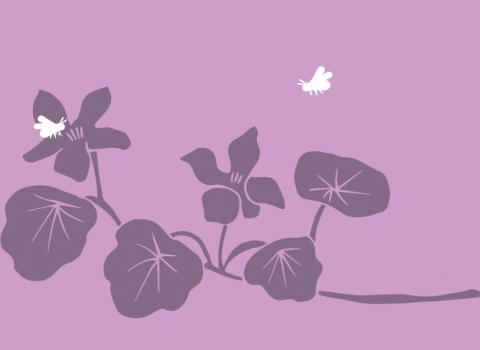Bumblebees look for certain types of flower. Here's what to plant for them in your garden.
Bumblebees have different length tongues, some short and some long, and as result, they prefer different types of flowers. Bumblebees with shorter tongues need short, open flowers with nectar within easy reach. This includes flowers from the daisy family, and those like alliums, which have a number of small flowers on one stalk. This type of flower offers a small reward for each probe, unlike the deeper flowers, which have significantly more nectar per flower.
Some bee species have even resorted to ‘robbing’ the nectar by cutting a hole in the base of the flower and getting at the nectar that way! The flower loses out because this means its pollen is not transported to other flowers nearby.
Some bumblebee flower favourites
- Buff-tailed and white-tailed bumblebees prefer short open flowers e.g white clover, comfrey. Both are hole-biting ‘nectar robbers’. Buff-tailed bumblebees rarely visit pendulous flowers as its large size means it is not agile enough to do so.
- Garden bumblebees have a long tongue so they can visit flowers with petals that form long tubes such as honeysuckle, delphiniums and catmint.
- Red-tailed bumblebees are a large bee and like to land on flowers with ’platforms’ e.g. daisy family, especially knapweeds.
- The early bumblebee is a small agile size with a medium-length tongue that means it can probe a range of flower depths and is able to visit upside-down and drooping flowers such as comfrey and viper’s bugloss.
- Common carder bees are long-tongued and able to get nectar from long-tubed flowers, especially late flowers of white deadnettle, but also visit a wide variety of flowers. Male bees seem to visit compound daisy-like flowers (e.g marsh thistle) more than females.
30 Plants popular with bumblebees
As with any planting for nectar, having some early and late flowers in the mix will prolong the nectar season for bumblebees. Planting them in drifts will help bees recognise them and allow them to visit repeatedly.
- Agastache (agastache sp)
- Betony (stachys officianlis)
- Borage (borago officianalis)
- Broad bean (vicia g faba)
- Buddleia (buddleia davidii)
- Bugle (ajuga reptans)
- Catmint (nepeta)
- Chives (allium schoenoprasum)
- Clovers (trifolium)
- Comfrey (spymphytum officianale)
- Cranesbill (geranium)
- Curry plant (helichrysum angustifolium)
- Figwort (scrophularia nodosa)
- Foxglove (digitalis purpurea)
- Honeysuckle (lonicera)
- Heather (calluna, erica)
- Knapweed (centaurea)
- Lavender (avandula angustifolia)
- Marjoram (origanum vulgare)
- Mints (mentha)
- Nasturium (tropaeolum majus)
- Poached Egg plant (limnanthes douglasii)
- Rosemary (rosmarinus officianalis)
- Sage (salvia officianalis)
- Larkspur (delphinium)
- Snapdragon (antirrhinum)
- Thistles (cirsium)
- Toadflax (linaria vulgaris)
- Verbascum (verbascum)
- Viper’s bugloss (echium vulgare)
- Woundworts (stachys arvensis)
| Early flowers | Late flowers |
|---|---|
| Aubretia (aubretia) | Buddleia (buddleia davidii) |
| Dandelion (taraxacum) | Ceanothus (ceonothus) |
| English bluebells (hyancynthiodes non-scripta) | Cone flower (echinacea) |
| Flowering currant (ribes sanguinium) | Goldenrod (solidago candensis) |
| Forget-me-not (myosotis arvensis) | Ivy (hedera helix) |
| Hazel (corylus avellana) | Lavender (lavandula) |
| Primrose (primula vulgaris) | Michaelmas daisies (aster) |
| Pussy willow (alix caprea) | Red valerian (centranthus rubra) |
|
Wallflower (Erysimum cheiri) |
Sedum (sedum spectabile) |
| White deadnettle (lamium album) | Hyssop (hyssopus officinalis) |
Top tips
Provide both long and short grass too - long grass with wildflowers, such as daisies and dandelions, provides an easy source of nectar.
Avoid pesticides - try to avoid chemicals like pesticides and never use on plants when they are in flower. Instead, try to encourage natural predators by leaving log piles or creating an insect hotel.
Remember water - bees need a drink too. Can you create a wildlife pond? Or alternatively how about a bucket sunk into the ground or a birdbath containing a few submerged rocks to enable bees to reach the water?

